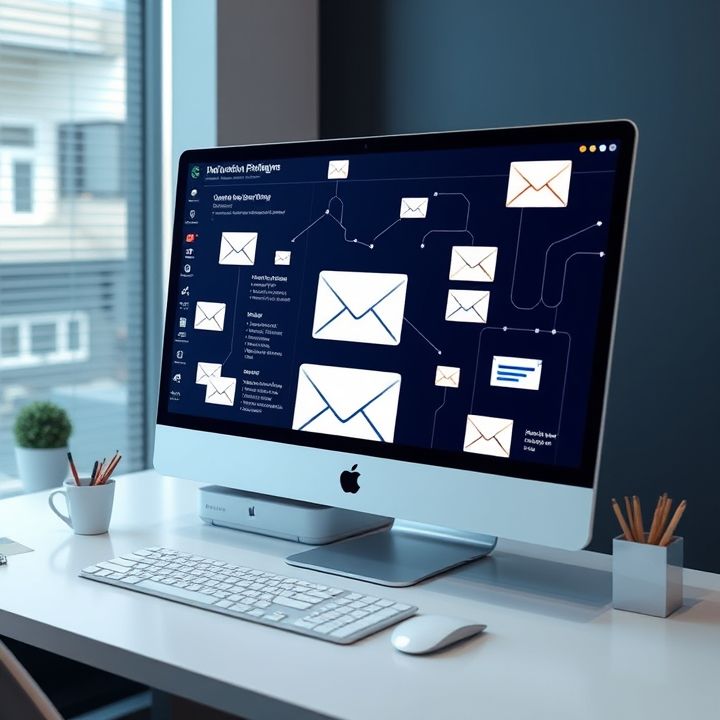Table of Contents
- Introduction
- Understanding the Customer Journey: Defining Stages and Touchpoints
- Collecting and Analyzing Customer Data: Insights for Personalization
- Mapping Customer Emotions and Needs: Crafting Relevant Content
- Segmenting Your Audience: Tailoring Email Content for Different Personas
- Designing Email Sequences for Each Stage of the Journey
- Testing and Refining Email Strategies Through Customer Feedback
- Integrating Email with Other Marketing Channels: Omnichannel Approach
- Measuring Success: Metrics and KPIs for Email Sequence Performance
- Conclusion
- Frequently Asked Questions
Introduction
Are you tired of sending emails that vanish into the void, gathering digital dust instead of views and clicks? Unlock unprecedented engagement by mastering the art of email sequences with the powerful tool of customer journey mapping. Imagine having the ability to craft emails that not only grab your audience’s attention but also guide them smoothly through the sales funnel. Discover how professional marketers leverage these techniques to maximize their reach and impact.
Here’s a sneak peek into what mastering email sequences can achieve:
| Benefit | Description |
|---|---|
| Increased Open Rates | Create interest-piquing subject lines designed for your target audience. |
| Higher Click-through Rates | Craft seamless journeys that guide your readers to take action. |
| Boosted Sales | Deliver the right message at the perfect moment. |
Join us as we delve into the secrets of creating compelling email sequences that resonate with your audience and drive measurable results. Ready to transform your email marketing strategy? Let’s dive in!
Understanding the Customer Journey: Defining Stages and Touchpoints
Understanding the customer journey is pivotal in crafting effective email sequences, as it allows businesses to tailor messages that resonate at each stage of the buying process. The customer journey is typically divided into several key stages: awareness, consideration, decision, retention, and advocacy. Each stage represents a different level of engagement and interest from the customer, requiring specific types of communication. For instance, during the awareness stage, potential customers are just discovering your brand, so introductory emails that educate and inform are most effective.
Touchpoints within these stages are the interactions customers have with your brand, such as visiting your website, opening an email, or purchasing a product. Mapping these touchpoints enables businesses to understand where customers interact most and how they can optimize these interactions to guide them further along the journey. By identifying these points, companies can send targeted emails that not only provide the information the customer needs but also strategically move them toward making a purchase decision. The ultimate goal is to maintain engagement throughout the journey by delivering relevant and timely content that meets the customer’s evolving needs and strengthens their relationship with your brand.
Collecting and Analyzing Customer Data: Insights for Personalization
In the realm of digital marketing, collecting and analyzing customer data is crucial for crafting personalized and effective email sequences. By mapping the customer journey, businesses can accumulate valuable insights into consumer behavior, preferences, and interactions. This data is gathered through various touchpoints, such as website visits, social media interactions, and previous purchase histories. Once collected, businesses can analyze this data to identify patterns and trends, allowing them to tailor their email marketing strategies to meet the unique needs of their audience.
Personalization takes many forms, from addressing the customer by name to offering product recommendations based on past purchases. When done effectively, it enhances the customer experience, fosters loyalty, and increases conversion rates. Additionally, data analysis enables marketers to segment their audience, ensuring that the right message reaches the right individual at the optimal time. This segmentation can be based on demographics, behavior, or even stages in the customer journey. Therefore, leveraging customer journey mapping and data analysis not only provides actionable insights for personalization but also drives engagement and improves the overall effectiveness of email campaigns.
Mapping Customer Emotions and Needs: Crafting Relevant Content
Mapping customer emotions and needs is a crucial step in crafting relevant email content that resonates with your audience. By understanding the different stages of the customer journey, businesses can tailor their email sequences to address specific pain points and desires. This personalized approach not only enhances customer engagement but also increases the likelihood of conversion.
One effective way to map these emotions and needs is through the creation of detailed customer personas. These personas should highlight the diverse characteristics and motivations of your target audience, allowing you to identify what content will appeal to them at various stages of their journey. Additionally, leveraging data analytics and feedback from previous interactions can provide insights into customer preferences and concerns.
Once you have a clear picture of your customers’ needs and emotions, you can craft compelling content that guides them efficiently through the sales funnel. For instance, during the awareness stage, focus on informative content that highlights the value of your product or service. As customers progress to the consideration stage, provide detailed comparisons and testimonials to build trust. Finally, in the decision stage, offer personalized discounts or incentives to encourage purchase.
In conclusion, effectively mapping customer emotions and needs ensures that your email sequences deliver the right message at the right time, leading to successful outcomes.
Segmenting Your Audience: Tailoring Email Content for Different Personas
Segmenting your audience is a vital step in crafting personalized email content that truly resonates with diverse customer personas. By understanding the various demographics, interests, and behaviors of your audience, you can tailor your messages to fit their unique needs and expectations. This approach not only enhances engagement but also fosters a deeper connection with each customer.
To effectively segment your audience, start by collecting and analyzing data to identify distinct groups within your customer base. Consider factors such as age, gender, past interactions, purchasing history, and any feedback they might have provided. Then, create tailored email content that speaks directly to each persona’s specific preferences and pain points.
For example, a tech-savvy group may appreciate detailed insights about new gadgets, while young parents might be more interested in practical tips and discounts. By aligning your email sequences with the interests of each segment, you increase the likelihood of capturing their attention and encouraging interaction. Ultimately, this strategic approach to segmenting your audience and crafting personalized email content helps in building strong customer relationships, driving higher open rates, and improving conversion metrics.
Designing Email Sequences for Each Stage of the Journey
Designing email sequences for each stage of the customer journey is crucial to effectively engage and convert prospects. The journey typically consists of several stages: awareness, consideration, purchase, and retention. Each stage requires a tailored approach to communication in order to address the unique needs and expectations of the customer.
During the awareness stage, emails should focus on capturing attention and educating the audience. Content such as informative articles or videos can help prospects understand their problem and potential solutions. As customers move to the consideration stage, the emphasis should shift towards highlighting the benefits and features of your product or service. Testimonials, case studies, and detailed comparisons can be effective in nurturing interest.
In the purchase stage, personalized offers, and clear calls-to-action can encourage the final decision. Post-purchase emails should not be overlooked, as they are crucial for building loyalty and encouraging repeat business. Providing exclusive content, asking for feedback, and offering loyalty programs can maintain customer interest and satisfaction.
By aligning email sequences with each stage of the customer journey, businesses can create relevant and timely communications that enhance the overall customer experience and contribute to successful conversions.
Testing and Refining Email Strategies Through Customer Feedback
Incorporating customer feedback into your email marketing strategy is essential for creating effective and engaging email sequences. Testing and refining your emails through customer insights can significantly enhance your communication efforts. Start by gathering feedback through surveys, polls, or direct responses to your emails. This feedback provides valuable information about what resonates with your audience and what does not.
Use A/B testing to experiment with different email formats, subject lines, and content. Analyze the open rates, click-through rates, and conversion rates from these tests to identify which elements work best. Keep a close eye on metrics such as unsubscribe rates or customer complaints, as these can indicate areas needing improvement.
Based on the feedback and data obtained, refine your email strategy. Consider segmenting your audience further to tailor messages even more precisely. Regularly updating your email sequences to reflect changing customer preferences ensures your communication remains relevant and compelling. By continuously testing and refining your strategy, you can maintain engagement and foster long-term relationships with your audience.
Integrating Email with Other Marketing Channels: Omnichannel Approach
An omnichannel approach to marketing involves integrating email with other marketing channels to create a seamless and consistent customer experience. This strategy ensures that your messaging is consistent across all platforms, allowing you to reach your audience where they are most active. Emails are particularly effective when combined with channels like social media, content marketing, and web personalization as they allow you to tailor your messages to individual preferences and behaviors. For instance, leveraging data from social media interactions can enable you to personalize email content based on customer interests. Similarly, aligning email campaigns with content marketing efforts can enhance engagement by delivering valuable, targeted content to subscribers. Additionally, implementing web personalization tactics through synchronized email sequences ensures that users receive coherent messages, even when switching between devices or platforms. By unifying these channels, businesses can create a cohesive narrative that guides customers along their buying journey, from awareness to conversion. This integration not only strengthens brand consistency but also enhances the potential for increased customer engagement and loyalty.
Measuring Success: Metrics and KPIs for Email Sequence Performance
Measuring the success of your email sequences is crucial for optimizing performance and achieving your marketing goals. Several key metrics and KPIs can provide insights into how well your email campaigns are doing. Firstly, the open rate is a fundamental metric that indicates the percentage of recipients who opened your email. A higher open rate suggests that your subject lines are compelling and relevant to your audience. Secondly, the click-through rate (CTR), which shows the proportion of recipients who clicked on a link within your email, is critical for evaluating engagement levels and content effectiveness. Another important metric is the conversion rate, which tracks the percentage of email recipients who completed a desired action, such as making a purchase or signing up for a webinar. This helps in assessing the direct impact of your emails on business goals. Moreover, monitoring the bounce rate, both hard and soft bounces, is essential to maintain a healthy email list and ensure deliverability. Lastly, analyzing unsubscribe rates can reveal if your content is resonating with your audience or if adjustments are needed. By regularly evaluating these metrics, marketers can refine their strategies, enhance customer engagement, and boost overall email marketing performance.
Conclusion
In an era where personalization is paramount, mastering email sequences through customer journey mapping provides an invaluable edge. By understanding the distinct stages of the customer journey, businesses can design tailored communications that engage customers more effectively. Crafting content that aligns with customer emotions and needs not only enhances engagement but also drives higher conversion rates.
Moreover, segmenting your audience allows businesses to deliver more personalized experiences, fostering stronger connections with each customer. The integration of email with other marketing channels further amplifies this impact, creating a seamless omnichannel experience that resonates at every touchpoint. This strategic approach ensures that your messaging is cohesive, compelling, and timely.
Continuous testing and refinement using customer feedback is essential to the success of your campaigns. By monitoring key metrics and KPIs, businesses can evaluate the effectiveness of their email sequences and make data-driven improvements. Ultimately, leveraging customer journey mapping in email marketing not only boosts engagement and conversions but also strengthens customer relationships, paving the way for long-term success and loyalty.

